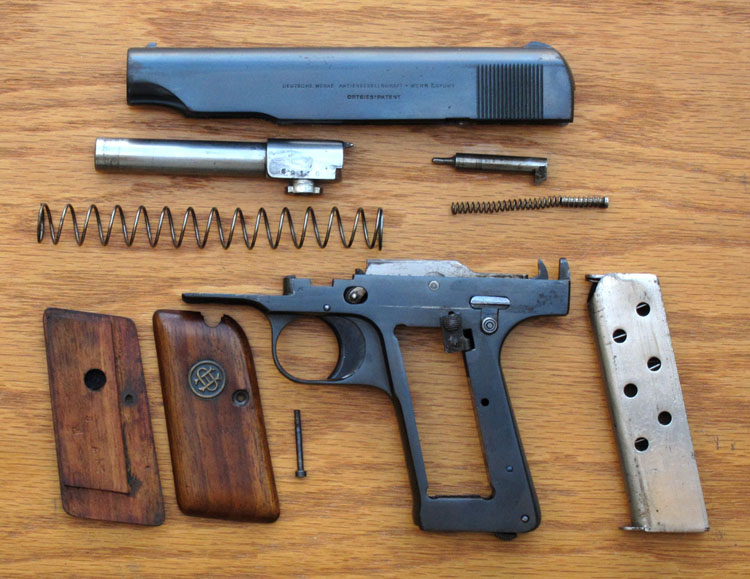
The guns were in large part a work program, creating export goods which could bring desperately needed hard currency into Germany to counteract the economic devastation of the Versailles treaty.
#ORTGIES PISTOL ASSEMBLY FULL#
In less than 5 full years (1919-1923), close to a half million of these guns were made, primarily by an industrial subsidiary of the German government. However, the most interesting part of the Ortgies story (in my opinion) is its production. 380 versions differ only in the easily-interchanged barrel – even the magazines are marked for both calibers. Mechanically, the Ortgies has a rather unusual grip safety mechanism that is quite different from what we expect to see today. The pistol was removed from her house following World War II, and has made its way through a few auction houses since.The Ortgies is a pistol whose interested aspects are often overlooked on the assumption that it is just another identical. It differs only slightly from a standard Ortgies pistol, in that it has a small gold plate inlaid into the side of the slide, stamped "Eva Braun". 32 ACP saw service with Finnish prison authorities throughout World War II Historic ExamplesĪn Ortgies pistol chambered in 6.35 mm, was presented to Eva Braun by Adolf Hitler. At the other end of the user spectrum, outlaw John Dillinger carried an Ortgies, and several hundred Ortgies pistols in both. In 1921, prize winners at some 70% of principal shooting competitions had chosen Ortgies 7.65 mm pistols, and the winner of the German championship on September 26, 1921, at Halensee, Germany, took the prize firing an Ortgies. The Ortgies was a well-balanced, sturdy weapon that found considerable favor in competitive shooting.

production and as well as early Deutsche Werke production.
#ORTGIES PISTOL ASSEMBLY SERIAL NUMBER#
No Ortgies pistol was produced with a chrome finish or, aside from one known salesman's sample, with factory engraving. The earliest gun noted by Koelliker is serial number 282, which he describes as having a round medallion with an intertwined HO (Heinrich Ortgies) monogram at the top center of the grips-these were the standard grip plates during all of Ortgies & Co. The latter finish could be either matte or bright. In keeping with prevalent economics in Germany at the time, factory finishes were limited to bluing or, rarely, nickel. For a short time thereafter, the slide marking was changed to "Deutsche Werke Aktiengesellschaft Berlin" before changing again to "Deutsche Werke Aktiengesellschaft Werke Erfurt," ultimately shortened to "Deutsche Werke – Werke Erfurt." Deutsche Werke pistols continued to feature the "HO" brass grip inset until relatively late in their production, when they substituted one with a new trademark depicting a stylized crouching cat with long tail forming an S-curve over its back. The production of the pistols eventually passed to Deutsche Werke in 1921, a shipbuilding company headquartered in Berlin. The weapons bore the mark "Ortgies & Co. – Erfurt" on their slides and a circular brass insert in their grips marked with a stylized "HO". After the war, he moved to Erfurt, Germany, where in 1919 he commenced production of the pistol in his own factory. Heinrich Ortgies designed the pistol while living in Liège, Belgium during World War I. Modern replacement magazines are purpose-built for one caliber only. One side of the magazine was marked for 7.65 mm and featured seven holes showing the positions that cartridges of that size would occupy when loaded the other side had similar holes and markings for 9 mm cartridges. 380 ACP) ammunition and were interchangeable between pistols of either calibre. Īt least the earlier Ortgies magazines could accommodate both 7.65mm (aka. To disengage the safety, a shooter simply would squeeze the grip, pressing the lever forward and locking it flush with the back of the frame. Thus, engaging the safety simultaneously reduced tension on the firing pin spring. The safety was a lever inset into the back of the grip and, with the gun cocked, forced backward out of the grip into the "safe" position by spring tension from the firing pin upon depression of a button under the slide. Unusual design features included the safety and the magazine. As in early Colt and Browning pocket pistols, the Ortgies striker also operated as an ejector as the slide traveled backwards after discharge. The hammerless action depended on a spring-loaded striker to fire the cartridge. Metal components were forged or machined, and assembly in general made no use of screws, even securing the wooden grips with a spring-loaded metal fastener inside the magazine well, although some examples do incorporate a single screw for that purpose. Although not expensive, at the time it was of advanced design and high quality construction with relatively few parts, well sealed against dirt.

The pistol was produced in 6.35 mm, 7.65 mm, and 9 mm Kurz variants, all using blowback as their operating mechanism.


 0 kommentar(er)
0 kommentar(er)
